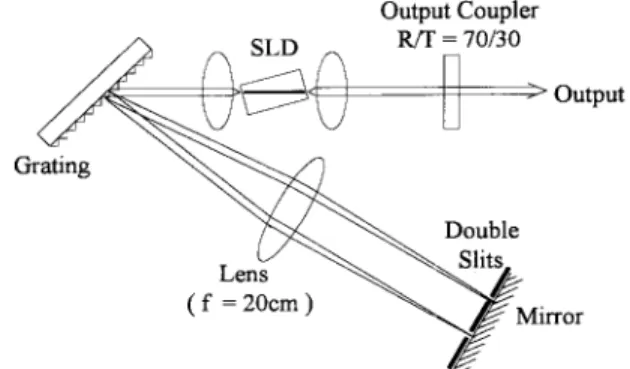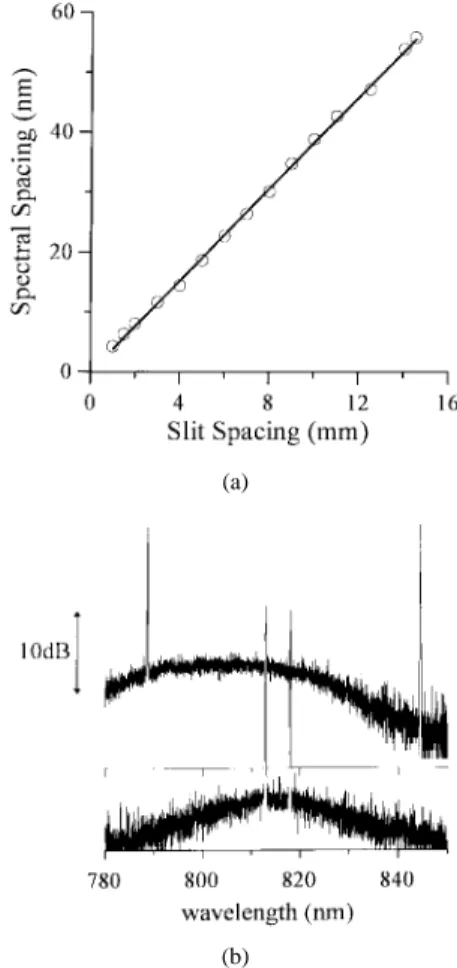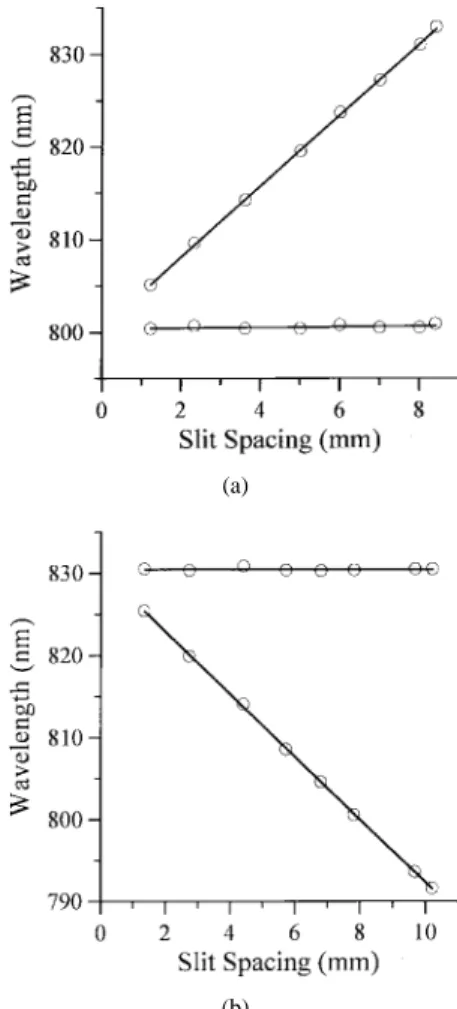1208 IEEE PHOTONICS TECHNOLOGY LETTERS, VOL. 10, NO. 9, SEPTEMBER 1998
Wide-Range Tunable Dual-Wavelength
Semiconductor Laser Using
Asymmetric Dual Quantum Wells
Ching-Fuh Lin,
Member, IEEE,Miin-Jang Chen, and Bor-Lin Lee
Abstract—Using asymmetric dual quantum wells for the laser
material, the semiconductor laser is able to operate at dual wavelengths with an extremely wide tuning range. The spectral spacing could be tuned to as large as 55.7 nm (25 THz). With the spectral spacing fixed, the two wavelengths could also be simultaneously tuned for a range as wide as 34.7 nm. In addition, with one wavelength fixed, the other one could be separately tuned. The experiments indicate that the two wavelengths can be almost randomly selected within a large spectral range over 30 nm.
Index Terms— Asymmetric dual quantum wells,
dual-wave-length operation, semiconductor laser, wavedual-wave-length tuning.
I. INTRODUCTION
D
UAL-WAVELENGTH laser sources have potential ap-plications in many areas such as wavelength-division multiplexing (WDM) communication system, two-wavelength interferometry, laser spectroscopy, differential lidar, optical data storage, and so on. Various approaches have been used to achieve simultaneous oscillation at two wavelengths in both fiber and semiconductor lasers. In fiber lasers, either multiple-coupled cavities with separate gain media or a common gain medium in a ring cavity is typically used for the dual- or multiwavelength operation [1], [2]. In semiconductor lasers, most works are achieved using an array of lasers with phys-ically separated gain media for each wavelength [3], [4]. Operation of dual-wavelength semiconductor lasers with the gain shared simultaneously by the two wavelengths has also been achieved [5], [6]. The use of a single-gain medium shared by both wavelengths has the advantage of simplicity because no elaborate fabrication and packaging procedures are required [6]. However, due to the strong gain competition [7], special care is required to keep the gain and loss in a well-balanced condition in order to have the two-wavelength oscillation. As a result, for a constant spectral spacing of 3.52 nm, simultaneous tuning of the two wavelengths is limited to a narrow range even with a reduced gain competition when an array is used as the shared gain region [6]. In this letter, we report that, using the gain medium with asymmetric dualManuscript received March 24, 1998; revised May 28, 1998. This work was supported in part by the National Science Council, Taipei, Taiwan, R.O.C., under Contract NSC87-2215-E-002-012.
The authors are with the Institute of Electro-Optical Engineering and The Department of Electrical Engineering, National Taiwan University, Taipei, Taiwan, R.O.C.
Publisher Item Identifier S 1041-1135(98)06262-4.
Fig. 1. A schematic of the experimental setup.
quantum wells (ADQW) [8], the semiconductor laser can be operated at two wavelengths with the spectral spacing tunable up to 55.7 nm. In addition, at a constant spectral spacing (5.5 nm), simultaneous tuning of the two wavelengths can be as large as 34.7 nm. Furthermore, at one wavelength fixed, the other wavelength can also be tuned.
Conventional semiconductor-laser gain medium using the quantum-well structure or heterostructure for the wavelength near 0.8 m has only 50-meV bandwidth, corresponding to about 300 ˚A in wavelength. By cascading two quantum wells of different widths, the gain bandwidth can be doubled [8]. Detailed design of the layer structure had been discussed in [8]. The superluminescent diodes (SLD’s) fabricated on the substrate with the designed ADQW demonstrate a spectrum that is two to three times wider than that of conventional SLD’s. The SLD’s used for the dual-wavelength operation in this work have a ridge waveguide that is tilted 7 from the normal of the cleaved facet in order to eliminate the gain ripple. The ridge waveguide is 6 m wide. The device length used for the experiment is about 350 m.
Fig. 1 schematically shows the experimental setup. A linear cavity is used. Two collimators (ThorLab C230TMB) with 4.5 mm and NA = 0.55 are used to collimate the light beams emitted from two facets of the SLD. The coupling efficiency of the collimators is about 70%. The laser cavity is formed between an output coupler with 70/30 and a reflection-type grating telescope. The grating has 1200 lines/mm and is Au-coated. Its efficiency is 80%. A lens with 20 cm is placed at 20 cm from both the grating and the mirror with 99%. According to the grating principle, the beams of different wavelengths are horizontally dispersed at the mirror
1041–1135/98$10.00 1998 IEEE
LIN et al.: WIDE-RANGE TUNABLE DUAL-WAVELENGTH SEMICONDUCTOR LASER 1209
(a)
(b)
Fig. 2. (a) Spectral spacing of two wavelengths versus the slit spacing (line: calculation; circle: experiment). (b) Measured spectra of two wavelengths at the spacing: 5 and 55.7 nm. (The output power of each wavelength is 2.3 mW and 1mW for spectral spacing 5 and 55.7 nm, respectively.)
with a spatial separation , where
is the spectral separation, is the grating period, is the first-order diffraction angle, and is the distance between the lens and the grating.
The broad-gain bandwidth resulting from the ADQW en-ables the emission to have a wide spectral width, so the dispersed light at the mirror expands horizontally more than half of the 1 diameter of the mirror. V-shaped double slits are inserted in front of the mirror to select two wavelengths for oscillation. The spectral spacing of the two wavelengths is varied by moving the V-shaped slits vertically. Fig. 2(a) shows the spectral spacing versus the slit spacing. Due to the broad-gain bandwidth, simultaneous oscillation at two wavelengths could occur with their spectral spacing as far as 55.7 nm, which corresponds to 25 THz in frequency. For the spectral spacing not larger than 55.7 nm, the output powers at the two wavelengths can be adjusted to be equal. Beyond 55.7 nm, two-wavelength oscillation is still possible, but their powers cannot be equal. In our experiment, the pumping current is limited to at most 210 mA. The maximum spectral spacing should increase if the pumping current is larger. Fig. 2(b) shows the measured spectra of two wavelengths with an almost equal power for two different spectral spacings, 5 and 55.7 nm. In this measurement, the output power of each wavelength is 2.3 mW at 200 mA pumping current for 5-nm spectral spacing
Fig. 3. Tuning spectra of two wavelengths at a fixed spacing of 5.5 nm. The pumping current is maintained at 200 mA within the tuning range.
and 1 mW at 210-mA pumping current for 55.7-nm spectral spacing, respectively.
Simultaneous tuning of the two wavelengths at a constant spectral spacing can also be achieved by moving the slits horizontally. For the two wavelengths with a wide spectral separation of 39 nm, they can be simultaneously tuned for a spectral range of 7 nm. For 5.5-nm spectral spacing, the two wavelengths can be simultaneously tuned for a range up to 34.7 nm. Fig. 3 shows the measured spectra of the simul-taneously tuned two wavelengths at 5.5-nm spectral spacing. In this measurement, the pumping current is maintained at 200 mA and the output powers at the two wavelengths are adjusted to be equal. The amplified spontaneous emission (ASE) suppression ratio is 20 dB for the entire tuning range. For this narrow spectral spacing, a strong mode competition is observed, but their powers can still be adjusted to be equal. If their powers are not necessarily equal, a larger tuning range can be achieved. An even wider range could also be obtained with a further reduced spectral spacing [9], but more efforts will then be required to maintain a good balance of the gain and loss because of increasing mode competition.
The reasons for the large tuning range are threefold. First, the gain due to the ADQW is broad [8]. Second, the two wavelengths that are contributed from two different wells have a much weaker competition [10] because the carrier transportation between quantum wells is a relatively slow process, compared to the intraband relaxation in the same well. The weak competition makes simultaneous oscillation of two wavelengths more easily occur [11]. From this point of view, using ADQW for dual-wavelength oscillation is better than
using 1 and 2 levels in the same quantum well
because the latter case suffers a stronger mode competition as a result of fast intraband relaxation. On the other hand, we have observed in the experiment that, as the two modes are contributed from the same well, they have a strong competi-tion. Then simultaneous oscillation at two wavelengths is more difficult to maintain, but is still achievable, as will be explained in the following third reason. In a well-aligned reflected-type grating telescope configuration, all the wavelength components should experience almost the same loss. Then two-wavelength
1210 IEEE PHOTONICS TECHNOLOGY LETTERS, VOL. 10, NO. 9, SEPTEMBER 1998
(a)
(b)
Fig. 4. Tuning of the second wavelength with the first wavelength fixed. (a) First wavelength fixed at around 800 nm. (b) First wavelength fixed at around 830 nm (line: calculation; circle: experiment). (The output powers of the two wavelengths could be adjusted to be equal in the shown tuning range for the pumping current above threshold.)
oscillation with an equal power will be possible only when the gains at the two wavelengths are about the same. Because the gain varies with wavelength, the two wavelengths can hardly have an equal gain for a wide spectral range. This should severely limit the tuning range. However, the optical components in reflected-type grating telescope configuration are usually slightly misplaced from their exact positions, so different wavelength components are not refocused by the collimator back to the same spot of the SLD facet, leading to a different coupling loss. This coupling loss depends on the mirror orientation. Therefore, although the gains at two wavelengths are different, equal powers at the two wavelengths can be achieved by slightly adjusting the mirror orientation to obtain a good balance between the gain and the loss.
The dual-wavelength operation of the semiconductor laser has been further investigated. With one slanted slit and one
vertical slit, one wavelength could be varied, while the other wavelength is fixed, when the slits are moved vertically. Fig. 4(a) and (b) shows the lasing wavelengths versus the slit spacing for one wavelength fixed at 800 and 830 nm, respectively. As shown in Fig. 4(b), the varied wavelength could be tuned with a range more than 30 nm. Their powers are adjustable and could be equal. The experiment has also shown that the fixed wavelength can be selected between 792 and 835 nm for the other wavelength tunable over a wide spectral range. The tuning experiments indicate that the two wavelengths can be almost randomly selected within a spectral range over 30 nm.
In conclusion, using the gain medium with ADQW, the semiconductor laser could oscillate at two wavelengths with the spectral spacing tunable up to 55.7 nm. In addition, the two wavelengths with a fixed spectral spacing can be simultaneously tuned with a tuning range as large as 34.7 nm. Such a wide tuning range is possible due to the weak gain competition, broad-gain bandwidth, and adjustable loss of the cavity configuration. Also, with one wavelength fixed, the other wavelength could be separately tuned. The fixed wavelength can be selected from 792 to 835 nm. Those experiments indicate that the two wavelengths can be almost randomly selected within a very large spectral range.
REFERENCES
[1] J. Chow, G. Town, B. Eggleton, M. Ibsen, K. Sugden, and I. Bennion, “Multiwavelength generation in an erbium-doped fiber laser using in-fiber comb filters,” IEEE Photon. Technol. Lett., vol. 8, pp. 60–62, 1996.
[2] J. M. Battiato, T. F. Morse, and R. K. Kostuk, “Dual-wavelength common-cavity codoped fiber laser,” IEEE Photon. Technol. Lett., vol. 9, pp. 913–915, 1997.
[3] K. O. Nyairo, I. H. White, C. J. Armistead, and P. A. Kirkby, “Multiple channel signal generation using multichannel grating cavity laser with crosstalk compensation,” Electron. Lett., vol. 28, pp. 261–263, 1992. [4] K. R. Poguntke, J. B. D. Soole, A. Scherer, H. P. LeBlance, C. Caneau,
R. Baht, and M. A. Koza, “Simultaneous multiple wavelength operation of a multistripe array grating integrated cavity laser,” Appl. Phys. Lett., vol. 62, pp. 2024–2026, 1993.
[5] T. Hidaka and Y. Hatano, “Simultaneous two wave oscillation LD using biperiod binary grating,” Electron. Lett., vol. 27, pp. 1075–1076, 1991. [6] C. L. Wang and C. L. Pan, “Tunable dual-wavelength operation of a diode array with an external grating-loaded cavity,” Appl. Phys. Lett., vol. 64, pp. 3089–3091, 1994.
[7] P.-C. Ku, C.-F. Lin, and B.-L. Lee, “Multiple cross switching in a two-mode semiconductor laser,” Appl. Phys. Lett., vol. 69, pp. 3984–3986, 1996.
[8] C.-F. Lin, B.-L. Lee, and P.-C. Lin, “Broadband superluminescent diodes fabricated on a substrate with asymmetric dual quantum wells,”
IEEE Photon. Technol. Lett., vol. 8, pp. 1456–1458, 1996.
[9] K.-S. Lee and C. Shu, “Stable and widely tunable dual-wavelength continuously wave operation of a semiconductor laser in a novel Fabry–Perot grating-lens external cavity,” IEEE J. Quantum Electron., vol. 33, pp. 1832–1838, 1997.
[10] C.-F. Lin and B.-L. Lee, “Bi-directional switching based on semicon-ductor laser/amplifier with shallow-etched bending ridge waveguide,”
Appl. Phys. Lett., vol. 71, pp. 1903–1905, 1997.
[11] A. E. Siegman, Lasers. Mill Valley, CA: Univ. Science, 1986.


